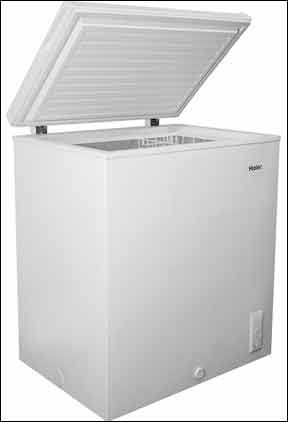Feeding fresh food to your dogs can help make them healthy and happy, but it can also be expensive, particularly for those with large dogs. Whether you feed a completely homemade diet or just want to improve your dog’s diet by adding fresh foods, there are many ways to reduce costs. Here are some ideas to consider:

288
1) BUY A FREEZER. Buying in bulk, or stocking up when you find good sales, is one of the best ways to save money on meat, but it requires having a place to store the food. A separate freezer gives you options that you won’t have if you’re trying to fit your dog’s food into your refrigerator’s small freezer along with your own food.
Buy the biggest freezer you think you might need; they fill up quickly. Chest freezers hold more, but it’s easier to find what you’re looking for in an upright model. Be sure to label food clearly, including the date it was frozen, so you don’t lose track of what’s in there.
If a new freezer is out of your price range, look for a used freezer on craigslist.org or other local listings. Keep in mind that older models are less energy efficient, so what you save in upfront costs may be quickly lost in your monthly electric bill.
2) FEED GRAINS. Many people who feed homemade diets, particularly raw diets, do not include grains. Sometimes this is necessary, as grains can contribute to inflammation, weight gain, and even seizures in some dogs. Not all dogs have problems with grains, however, and they provide inexpensive calories. If your dog is healthy and does not react to grains, there’s no reason to leave them out of the diet. Healthy grains to feed include rice (brown rice is more nutritious than white rice), oatmeal, barley, quinoa, and millet.
Other starchy foods that can be used in place of or in addition to grains include sweet potatoes, winter squashes, pasta, and regular potatoes. Colored vegetables provide the most nutrition.
Grains and starchy vegetables should not make up more than 50 percent of the total diet. All starchy foods need to be well cooked in order to be digestible by dogs.
3) JOIN A GROUP. If possible, join a co-op or raw feeding group in your area. Some groups buy directly from suppliers in order to get wholesale prices and take advantage of bulk discounts. Others may just exchange information about where to find unusual items and get the best prices.
If there is no group in your area, consider starting one if you know of other dog owners who might be interested. Groups that are far away can still provide ideas and information about how they are run and their product sources.
4) LOOK FOR BARGAINS. In addition to keeping an eye out for sales, talk to the meat managers at local stores to find out what they do with meat that is about to pass its “sell by” date. They might be willing to save them for you, especially if you buy regularly. Similarly, talk to the produce manager about how you might be able to pick up vegetables and fruits that might otherwise just be thrown out. Ask about egg cartons with broken eggs as well.
Meat managers may also be able to purchase cases of items for you that they don’t usually carry, such as beef heart or chicken necks. These parts are often less expensive than those more commonly sold for human consumption. You will likely have to buy the whole case, but you should get a bulk discount.
Ethnic markets are a good source for unusual and inexpensive parts. And don’t forget farmer’s markets for fresh, locally grown produce. Talk to the vendors about purchasing products that might otherwise be discarded at the end of the day.
Hunters can also be a source for cheap (or even free) meat. While the hunters want the meat, other less desirable parts, such as the heart, liver, kidney, and tongue, may just be thrown away. As long as the organs are healthy, they’re fine to feed to your dog. Contact your state wildlife department to find butchers who process wild game in your area if you don’t have friends who hunt.
5) DON’T TRY TO BE PERFECT. Some dog owners won’t feed fresh foods because they insist on feeding only organic food, and it’s too expensive. While organic foods are great, even ordinary supermarket foods are healthier for your dog than processed dog food.
If you don’t have time or can’t afford to feed a complete homemade diet, you can improve your dog’s overall nutrition by adding fresh foods to a commercial diet, or by feeding homemade meals once or twice a week. Healthy leftovers (not fatty trim) are also good for your dog and cost nothing to feed.
Mary Straus is the owner of DogAware.com; see “Raw Food Resources” on that site to find local co-ops and buying groups. Straus and her Norwich Terrier, Ella, live in the San Francisco Bay Area.






